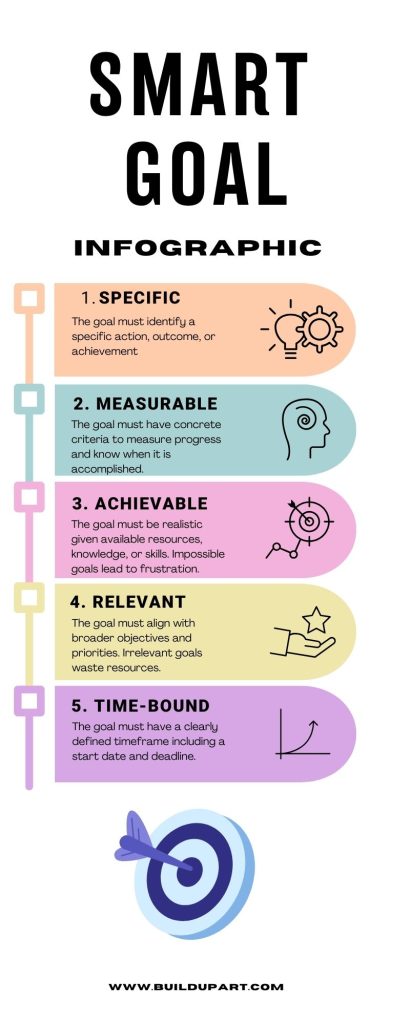Setting goals is an integral part of personal and professional development. However, simply having goals is not enough – you need a framework to set effective goals that you can realistically accomplish. This is where SMART goals come in.
SMART is an acronym that stands for Specific, Measurable, Achievable, Relevant, and Time-bound. It provides a methodology for setting well-defined goals that are action-oriented and have a higher likelihood of being achieved. In this comprehensive guide, we will demystify SMART goals by explaining what they are, why they are effective, and how to put them into practice.
What Are SMART Goals?
SMART is a goal-setting framework that helps you set clear, tangible goals with actionable steps. SMART goals are:
- Specific: The goal must identify a specific action, outcome, or achievement. Vague goals are difficult to accomplish.
- Measurable: The goal must have concrete criteria to measure progress and know when it is accomplished.
- Achievable: The goal must be realistic given available resources, knowledge, or skills. Impossible goals lead to frustration.
- Relevant: The goal must align with broader objectives and priorities. Irrelevant goals waste resources.
- Time-bound: The goal must have a clearly defined timeframe including a start date and deadline. Open-ended goals tend to never get done.
SMART goals incorporate these elements to help focus your efforts, use time and resources effectively, and minimize obstacles in meeting the goal.

Why Are SMART Goals Effective?
SMART goals are widely used by individuals and organizations because they offer several benefits:
- Clarity: SMART goals provide clarity on what you want to achieve, making it easier to focus efforts in the right direction.
- Motivation: The tangible nature of SMART goals helps maintain motivation as you have clearer milestones.
- Productivity: Specific action steps help boost productivity toward goal achievement.
- Measurement: Quantifiable metrics allow tracking progress and identifying potential improvements.
- Alignment: Goals aligned to needs and priorities are more impactful. SMART goals help ensure relevance.
- Execution: SMART goals are easier to execute with definite timeframes, action plans, and milestones.
Overall, SMART goals create a framework for establishing goals that have a greater likelihood of being accomplished within the defined parameters.
How to Write SMART Goals
Follow these steps to write effective SMART goals:
- Identify the goal objective – Start by deciding on the overall goal or purpose you want to accomplish. Think about what you want to achieve.
- Make it specific – Define who, what, when, where, why, and how for your goal. Make it laser-focused.
- Quantify it – Include measurable targets that indicate progress like metrics, percentages, numbers, etc.
- Assess achievability – Ensure the goal is realistic given constraints like resources, skills, and timeframes. Break big goals into smaller objectives if needed.
- Check relevance – Confirm the goal aligns with your needs, values, and bigger objectives. This helps maintain motivation.
- Define timelines – Set a specific deadline for goal completion along with milestones and timelines. This creates accountability.
- Write it down – Document the goal clearly defining each SMART element. Writing it cements commitment.
Let’s look at some examples:
| Vague goal | SMART Goal |
| Get in shape. | Lose 15 pounds by going to the gym 3 times a week for the next 3 months. |
| Increase customer satisfaction. | Achieve 90% customer satisfaction rate by Q4 as measured by post-interaction surveys. |
| Improve my presentation skills. | Complete an online presentation course and deliver 5 client presentations with over 85% positive feedback by December. |
Writing SMART goals takes practice. Use the above framework until it becomes second nature. Track your progress periodically and tweak goals as needed. Over time, SMART goals will help drive results.
FAQs
How do you prioritize?
– List all your goals and rank them by importance and urgency. Higher priority goals that are time-sensitive should be worked on first. Break large goals into smaller tasks to make them more manageable. Schedule priorities and start working on them.
Can you have too many SMART goals?
– Having too many can be counterproductive. Goal overload can lead to spreading yourself too thin. Focus on 3-5 critical SMART goals at any time. Accomplish them before setting more goals. Say no to distractions that detour you from high-priority goals.
What happens if you don’t achieve ?
– Not achieving a SMART goal is not failure. Review what went wrong and identify learnings. Then decide whether to continue efforts toward the existing goal with updated timelines or resources. Or recognize that the goal may no longer be realistic or relevant and move on to new goals that align with your current priorities.
How often should you review SMART goals?
– Review your goals at least once a month. Evaluate progress against milestones and metrics. Celebrate successes. If lagging, determine if more effort is needed or if the goal needs adjustment. Adjust timelines or resources accordingly. Regular reviews keep you accountable.
How do you track the progress of SMART goals?
– Break goals into smaller milestones with target dates. Accomplishing milestones marks progress. Setup a tracking chart listing each milestone and goal metric. Update periodically with results, comments, and next steps. Automate where possible. Reviews help maintain momentum.
The Power of SMART Goals
SMART goals may seem restrictive at first, but the framework helps drive disciplined, focused efforts towards your most important objectives. With consistent practice, writing goals becomes easy and eventually a habit as you experience the benefits of effectively achieving your goals. So start applying SMART to create clear, actionable goals that bring you closer to the results you desire – both personally and professionally.



